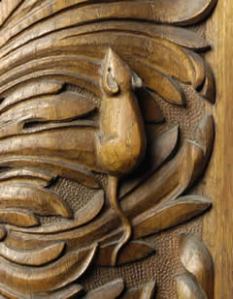 A wooden bookend or a bowl or a cheese board that features a carved mouse sounds like a mere novelty, yet there are warnings on, of all places, eBay, cautioning potential bidders against frauds, fakes and forgeries. And one begins to understand the value of the object’s possible legacy. Robert Thompson was an original, the only Mouseman, a consummate artist-craftsman of North Yorkshire, England, who came of age in the last decade of the nineteenth century, who snubbed the machine-age in favor of the arts-and-crafts movement, who decided to make the mouse his logo by carving him onto almost every piece of his furniture.
A wooden bookend or a bowl or a cheese board that features a carved mouse sounds like a mere novelty, yet there are warnings on, of all places, eBay, cautioning potential bidders against frauds, fakes and forgeries. And one begins to understand the value of the object’s possible legacy. Robert Thompson was an original, the only Mouseman, a consummate artist-craftsman of North Yorkshire, England, who came of age in the last decade of the nineteenth century, who snubbed the machine-age in favor of the arts-and-crafts movement, who decided to make the mouse his logo by carving him onto almost every piece of his furniture.
Thompson’s mouse debuted sometime around 1920. “I and another carver were carving a huge cornice for a screen,” Thompson would later write, “and he happened to say something about being as poor as a church mouse. I said I’ll carve a mouse here and did so, then it struck me what a lovely trade mark.”[1] And thus the first of Thompson’s mice was born, the genesis of his moniker “the Mouseman of Kilburn.” His work was of the ecclesiastical nature, woodwork for humble churches and noble cathedrals, across the towns and villages of northern England.
At age fifteen he apprenticed to an engineer about sixty miles southeast of Kilburn, the country village where he was born and raised and where he would return after five years to join his father’s joinery shop. According to Patricia Lennon—author of a small, quirky book that is at once a short biography of Thompson and a travel guide with driving tours to see Thompson’s mice—his trips to and fro during his apprenticeship took him through Ripon and he would frequently stop and admire its cathedral’s 15th century misericords—carvings, often fanciful, found on the underside  of the seats in the choir stall—exquisitely produced by William Bromflet. It was Bromflet’s work that helped Thompson to see how woodworking could be turned into art. Following in the footsteps of his medieval forebears, Kilburn’s Mouseman worked solely with English oak, cured it naturally not in a kiln, and colored the wood with the fuming process—the honeyed tint that is achieved when ammonia interacts with the wood’s tannin. He snubbed nails and screws, eschewed the clackety-clack of mechanized lathes for the opportunity to work his knuckles to the bone. He chose the adze to define his craftsmanship in the soft ripples the shaping tool made in the wood, resulting in furniture that was in equal parts graceful and rustic. By 1930 his small shop was filled with ten apprentices of his own. He considered each one “to be fully trained once they could carve the mouse to his exacting standards.”[2]
of the seats in the choir stall—exquisitely produced by William Bromflet. It was Bromflet’s work that helped Thompson to see how woodworking could be turned into art. Following in the footsteps of his medieval forebears, Kilburn’s Mouseman worked solely with English oak, cured it naturally not in a kiln, and colored the wood with the fuming process—the honeyed tint that is achieved when ammonia interacts with the wood’s tannin. He snubbed nails and screws, eschewed the clackety-clack of mechanized lathes for the opportunity to work his knuckles to the bone. He chose the adze to define his craftsmanship in the soft ripples the shaping tool made in the wood, resulting in furniture that was in equal parts graceful and rustic. By 1930 his small shop was filled with ten apprentices of his own. He considered each one “to be fully trained once they could carve the mouse to his exacting standards.”[2]
.
[1] Patricia Lennon, The Tale of the Mouse: The Life and work of Robert Thompson the Mouseman of Kilburn, Great Northern Books, 2001, p. 13.
[2] Ibid., p. 15.
Also, see Robert Thompson’s Craftsmen.
Images: Photograph of Robert Thompson at work; Mouse on one of the pieces of furniture that he made for the Leeds Girls’ High School library, 1933.